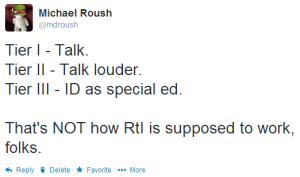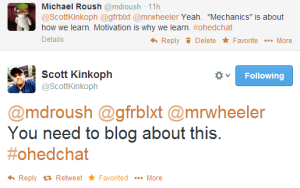originally posted December 2, 2011, at http://www.ohioregion14.org/perspectives/?p=767. It’s still good, so I’m re-posting it here.
Simulations can be an engaging, effective way to immerse students in a concept. They can also be a good way to spark a student’s interest in a topic by making the factual information to be learned seem “more real”, because it has an immediate purpose – advancing in the game.
Simulations generally require students to learn facts for a purpose beyond simply repeating them on a test. Simulations also often require exercises in decision-making and problem-solving that reach into the upper levels of higher-order thinking skills. Some simulations can be very expensive, though. And just because something is a simulation does not guarantee it will be either educational or engaging!
Here are my ten favorite free online educational simulations!
10) Blood Typing
http://www.nobelprize.org/educational/medicine/landsteiner/
Why do blood types matter? See what happens when three accident victims come to the emergency room. They all need transfusions, but none of them know their blood type. Can you figure it out in time to save them all?
9) Trade and Economics
http://www.nobelprize.org/educational/economics/trade/
Why do some countries specialize in certain goods? Do imports and exports really matter? How do production decisions in one part of the world affect other countries? Explore these questions in a wonderfully developed simulation of the Heckscher-Ohlin trade theory. Playable in minutes, and great for playing numerous times in one sitting. Allows students to adjust their strategy from one game to the next in order to achieve a higher score.
8) Zapitalism
http://www.Zapitalism.com/
Nice simulation of starting with a small retail store, and taking it to profitability based on the important decisions you make. What should you sell? How high should your prices be? What are the other stores around you selling?
7) Arm Surgery 2
http://www.learn4good.com/games/simulation/doctor-hospital-games-for-kids.htm
Seriously? Arm surgery? Yep! But don’t worry, the animation is “cartoony” enough that you shouldn’t be causing anyone to faint. And the subject matter is likely to have someone in your class saying “Hey, that happened to me!”
6) Cargo Bridge
http://limexgames.com/studio/games/cargo_bridge
Triangles. Leverage. Force. Momentum. Planning and Architecture. Resource management. It’s all part of “Cargo Bridge” (and its expanding variants, like the Armor Games Edition, and Christmas Levels Pack)! Use your knowledge of structures and force to keep advancing through higher and more difficult levels.
5) The River City Project (No longer free)
(Intro) http://muveb.gse.harvard.edu/~muvers/rivercityvideos/River_City_Fall_Large.mov
I’m breaking my own rule here by including a simulation that USED to be free, but is now licensed. In a sense, it was never free… funding used to be covered by a federal grant, but that grant has expired. The fact that the simulation is still available at all is a good thing, because it’s well constructed, and plays very well. Students who do not just rush through the game will be rewarded for their attention to details and recording of interesting facts gathered from interacting with the virtual world and the people in it.
4) GCF Learn Free – ATM
http://www.gcflearnfree.org/everydaylife/atm
Simulations can be used to place students in situations they never would find themselves in, to give them an idea of what life is like from other perspectives. But sometimes, simulations can be used to give students an idea of what life could be like for them in a year or two, or ten! GCF Learn Free’s ATM Simulation is one of the latter. Using an ATM may be second nature to many people today, but for some students, this is a vital skill they will need in order to function in society. This simulation gives them a safe way to experience using an ATM for themselves. GCF Learn Free simulations include printable worksheets to go along with the online activities.
3) The POD Game
http://www.thepodgame.com/
Do your high school students think they’re good in a crisis? Let them find out with this scary simulation, funded by the Center for Disease Control and developed by the Chicago Department of Public Health and CADE. An airplane has released deadly anthrax virus over the city, and you are working in a drug dispensing center’s Point-Of-Dispensing (POD). Take the training, and then see if you have what it takes to take the role of a Medical Screener, Forms Reviewer, or Dispensing in a tense situation.
2) Mission US – For Crown or Colony?
http://www.Mission-US.org/
Take up the role of Nat Wheeler, a 14-year-old boy in Boston. The time is the days leading up to the beginning of the Revolutionary War. As Nat, participants make decisions that impact the progression of the game, while learning important facts. Teachers can register an entire class and keep track of their progress through the well-constructed simulation. Don’t miss the fun mini-game “Pennywhistle Hero”!
Two more games have been added to this series. “Flight to Freedom” has students playing the part of a runaway slave in the time leading up to the US Civil War, and “A Cheyenne Odyssey” puts students in the northern plains in 1866 as part of a Native American tribe!
1) The Oregon Trail
The grandaddy of educational simulations! The one that basically started it all! New versions exist for mobile devices, but they aren’t nearly as heavy on requiring independent thought and planning.
Start in Independence, Missouri, and plan your trip westward to start a new life for you and your family in 1848.
Original edition FREE online
ActiveGS version
http://www.virtualapple.org/oregontraildisk.html
Java Version
http://www.virtualapple.org/J_oregontraildisk.html



